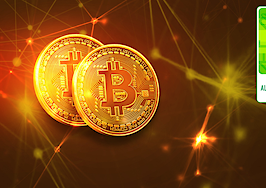Real estate agents know that mortgage rates drive homebuyer demand, but what economic factors influence mortgage rates? This article explains the economy so agents understand why the market slowed down, what is ahead, and how to discuss the economy with clients and prospects.
The economy
The economy is dominating the news, and the housing sector has turned on a dime. The supercharged seller’s market is gone, and we are trying to figure out what’s ahead for homebuyers and sellers.
It’s a perfect time to focus on the economy. In June, I wrote in my weekly crypto newsletter, “We are at a point where we are saying goodbye to rising asset prices, stable pricing of consumer goods, a red hot housing market, a rising stock market, record low unemployment, and a crypto market that has outperformed all investments.”
Pretty much all of those things came true — asset prices dropped, the housing market has turned, and the stock market and crypto have plunged. The only piece that hasn’t responded to the Federal Reserve’s increase in rates has been unemployment. As I’ll discuss below, that is problematic for the Fed.
Economic issues touch everyone, but they are especially relevant to prospective homesellers and buyers. This article will explain the economic levers that directly drive the real estate market without using “Fed speak” or a lot of economic terms. After you digest it, you’ll feel comfortable discussing real estate issues in the context of economic news.
Dark days ahead?
It’s not a good sign when a highly regarded economist I follow, Nik Bhatia, entitles his weekly newsletter, “Financial Instability, Liquidity Drying Up, Alarm Bells Ringing.” And Bhatia is not an outlier. For several weeks, the financial, business and economic news has been disheartening.
Instead of disputing the news, searching for a ray of sunshine or ignoring it, I wanted to go beyond the headlines and understand what is going on.
Below, I discuss inflation, CPI, The Federal Reserve, the Fed’s Fund Rate, Terminal Rate, Prime Rate, U.S. Treasurys, the Inverted Yield Curve, the Consumer Sentiment Index, Mortgage Rates, New Construction, Unemployment, Commodities, and the impact of the strong dollar on the Global Economy.
US inflation rate
Inflation is a measure of the decline of purchasing power and is tracked by the U.S. Bureau of Labor Statistics. They calculate the Consumer Price Index (CPI) by measuring the average change in price, over time, of a “basket” of selected goods and services.
The CPI is based on 94,000 price quotes from 23,000 retail and service establishments and 43,000 rental housing units.
Inflation is at a 40-year high and peaked in June at 9.1 percent. It dropped slowly in July, August, and September, 8.5 percent, 8.3 percent, and 8.2 percent, respectively. However, the Federal Reserve expected a faster decline. The current rate is also quite a distance from the 2 percent target inflation rate — last experienced in February 2021.
The Fed has the job of taming inflation. It is mandated to use monetary policy to achieve stable pricing and maximum employment.
The Fed can slow down inflation by making it more painful for people to spend money. They do this by raising the “Fed funds rate.” The federal funds rate is the rate that banks charge each other for lending cash or excess reserves. It is also the rate commercial banks lend to each other.
On Sept. 22, 2022, the Fed set its target range at 3 percent to 3.25 percent. This was a 0.75 percent increase.
The Fed’s longer-term projections were also revealed. Comparing the June projections to the current projections revealed that the Fed underestimated inflation. Inflation has turned out to be more difficult to control than anticipated. Their hawkish language was clear — the Fed will do whatever is necessary to bring down inflation.
Fed Vice Chair Lael Brainard said, “Monetary policy will be restrictive for some time to ensure that inflation moves back to target over time.”
Market Insight Tip: The “terminal rate” is a mapping of projected rates over time on a “dot plot.” It shows that the Fed policymakers in September envisioned that to tame inflation, they would need to raise the Fed Funds rates to 4.375 percent by the end of 2022, and it will peak at 4.625 percent in 2023. This implies a slowing pace of rate hikes next year. However, it’s important to note that Fed policy decisions are data-driven, so the dot plot only reveals expectations at the time of the Fed’s last meeting.
Inflation is projected to drop from the current 8.2 percent to 5.4 percent by the end of 2022 and 3.1 percent in 2023.
Prime rate and consumers
The prime rate is the rate that commercial banks charge their most creditworthy customers. It’s based on the federal funds rate plus 3.
How is this reflected in consumer spending, which accounts for two-thirds of U.S. economic output?
The Commerce Department reported that retail sales on goods, like vehicles, furniture, and groceries, were unchanged from August to September.
Consumer behavior is essential in driving down inflation. If consumers feel that inflation is not over, they will continue spending because they don’t want to pay more for goods and services over the next few months. This could create shortages, which will then trigger higher prices. This is a cycle that won’t end well.
A reliable gauge of future consumer spending is the consumer sentiment index. It measures how consumers feel about their jobs and the economy by asking a handful of questions:
- Compared to a year ago, financially, are you better off, worse off, or the same?
- A year from now, do you think you’ll be financially better, worse, or the same?
- In a year, will U.S. business conditions be good, bad, or other?
- In the next five years, do you think the U.S. will see continuous good times or unemployment/depression?
- When it comes to major household appliances, is buying now a good time or a bad time?
The most recent index showed that consumers felt a bit better in September than in August, but their attitude about the economy is much more negative than last year. They are also pessimistic about the economy over the long term. (This jibes with the “inverted yield curve” discussed below.)
Households continue to benefit from the strong labor market, and gasoline prices have dropped since June. However, expect to see the slowing housing market weigh on purchases of goods such as furniture and appliances.
Market Insight Tip: Gas prices have declined by an average of $1.22 per gallon nationwide since their June peak — a decline of 24 percent over more than 18 weeks.
US Treasurys
Companies raise money by selling bonds. The U.S. government does the same, except that the U.S. bonds are secured by the government. This makes them a very safe investment.
The bondholder, the investor, pays a price for the bond and receives a yield as the bond matures. When it matures, the holder receives the face value of the bond.
The U.S. Treasury sells bonds through an auction, and the yield is set through a bidding process. Bonds are also sold on a secondary market by brokers and third parties.
The 10-year Treasury bond yield is important because it signals investor confidence.
When confidence in the U.S. economy is strong, and investors have a higher appetite for risk, they put their money into stocks, and the demand for bonds is low. However, when confidence in the economy is waning, investors want safe investments, and they move their money from riskier investments into Treasurys. Demand for bonds increases.
Bond yields serve as a window into how investors feel about the economy. Economists compare the 2-year and 10-year Treasury bonds.
Normally, investors expect to receive a higher yield when they tie up their money for a longer time period. This is true with Treasurys, and the 10-year bond usually pays a higher yield.
Recently, the 10-year yield has been lower than the 2-year. This phenomenon is known as an “inverted yield curve,” and it signals a recession. Except for one time, an inverted yield curve signaled every recession since 1955. It shows that investors are more confident in the short-term health of the economy than in the long-term.
Mortgage and housing
The Fed wanted to see a cooling of the housing market, and it certainly got it. After a series of historic increases in the fed funds rate, the housing market did an about-face.
Here’s how that happened:
The 10-year Treasury bond closely tracks 30-year fixed mortgages. When the 10-year Treasury yield moves up or down, it’s followed by mortgage rates.
According to Freddie Mac, rates on 30-year fixed mortgages will approach at or over 7 percent. A year ago, it was 3.05 percent. Today’s rates have not been this high since July 2007.
Selma Happ at CoreLogic said, “The surge in mortgage rates has brought the housing market to an impasse. Many buyers moved to the sidelines as the cost of homeownership became prohibitively high, while sellers were unwilling to give up locked-in record-low interest rates and expectations of peak sales prices.”
High mortgage rates have put the breaks on demand, and sellers are reluctant to sell because the days of insanely high-priced multiple offers are over. Also, sellers who refinanced are not willing to give up their current low mortgage rates.
What about new construction? U.S. homebuilder sentiment has fallen every month in 2022, according to surveys conducted by the National Association of Home Builders.
A lead analyst for HousingWire, Logan Hotashami, said, “No new building. This is almost useless; the housing market has already gone into recession, and the builders are done building anything new until they get rid of the excess supply they already have. We have 10.9 months of housing supply with 9.84 months in construction. The builders will take their time finishing these homes and ensuring they sell them at a price that is useful for their business model.”
After the last financial crisis, homebuilding dropped below historical norms for more than a decade. This resulted in the housing shortage that we have been experiencing.
It appears that this will continue, and there will not be sufficient inventory for the tens of millions of millennials looking to buy a house over the next decade.
Unemployment, commodities and the global economy
The unemployment rate dropped from 3.7 percent in August to 3.5 percent in September. This is tied at the half-century low of 3.5 percent. There are practically two job openings for every unemployed person seeking work.
Market Insight Tip: Many economists believe that the Fed tightening will not stop until unemployment increases.
Federal Reserve Chairman Jerome Powell has said the ratio of job openings to unemployed workers must narrow to bring the labor market into better balance. Even though the Fed is mandated to keep unemployment low, the current rate is too low. Many economists predict that the Fed tightening won’t stop until unemployment increases.
Major commodity prices have been falling, including copper. Copper is used in many products, and lower prices show a drop in global demand and the end of supply chain problems. This is considered a bellwether and indicates a contraction.
As The Fed raises rates to eliminate inflation, the U.S. dollar’s value is increasing around the world. This is wreaking havoc around the globe because the dollar is the world’s reserve currency.
According to the International Monetary Fund, 40 percent of the world’s transactions occur with the U.S. dollar.
In Europe, the dollar’s rise in value, compared to the British pound and Euro, is increasing inflation, which is already at 10.1 percent. Europeans are seeing 41 percent higher energy prices compared to a year ago. It is going to be a challenging winter.
New York Times reporter Patricia Cohen wrote in “The Dollar Is Strong. That Is Good for the US but Bad for the World” that a strong dollar is also worsening starvation in Nigeria and Somalia because it is increasing the price of imported food, fuel and medicine.
Foreign investment is also being curtailed in India and South Korea.
Rich Hopen is a licensed associate broker with the Short Hills, New Jersey office of Compass. He writes a weekly crypto newsletter, Crypto News for Realtors, and the Crypto Corner for Inman. Rich also has a YouTube channel.













